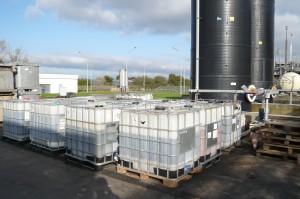At an upper-tier Seveso-rated centre for handling/treating hazardous industrial waste, a yellowish smoke smelling like chlorine was released around 10:40 am through the vents of a 30-m³ vertical tank containing 7 m³ of acidic wastes (pH=3) while an experienced technician was transferring 1,800 litres of solution tagged as “acid” from three 1,000-litre containers. The centre operator activated the site’s internal emergency plan and sprinkled the tank, causing the smoke to thicken. The facility’s 25 employees and some 100 others working at adjacent firms were confined indoors; a number of personnel sustained eye irritations.
Notified by the operator, municipal first responders arrived on the scene 15 minutes later in deploying a crew of 30 and 8 vehicles; 0.6 ppm of Cl2 were measured 3 m from the installation and 0.2 ppm recorded at the property boundary. The police set up a safety perimeter covering the entire site. The contents of the stationary reservoir were transferred into 10 containers. Upon the advice of another Group entity, the operator neutralised the mix using soda and rinsed the tank. The response lasted until 1 pm, at which time the safety perimeter was removed. The centre issued a press release.
The inspection authorities for classified facilities visited the site that afternoon. The 3 poorly labelled reservoirs had held liquid waste, originally a sodium chlorite (NaClO2)-based alkaline chemical product used to disinfect water intended for human consumption. Not granted a preliminary site acceptance certificate given the ongoing analyses to determine an appropriate treatment stream, one of the centre’s marketing reps convinced the client’s water purification plant to ship its waste using a “mineral acid” type certificate.
A technician sampled the shipped waste upon arrival and measured a pH of 9, yet without noting the inconsistent tag. The preliminary “tank bottom” test, designed to verify the compatibility of the waste scheduled for transfer with that already present in the tank, was not representative of the reaction risks for the volumes introduced, namely 100 ml extracted from the waste delivered for a tank containing 10 to 15 litres. The improvised use of a chemical neutralising agent without prior analysis, as specified in the internal emergency plan, might have exacerbated these risks. Moreover, the hazard of a mix with large quantities of incompatible products had not been identified in the initial analysis conducted as part of the protocol of a recent study, which instead only examined a scenario leading to a mix of 30 litres of sodium hypochlorite (bleach) with 30 litres of acid solution.





